Abstract
The acceptability and pharmacology of intermittent aerosol administration of amantadine was assessed in healthy volunteers. Amantadine solutions of 2.5, 1.5, or 1.0 g/100 ml were used for 12 30-min, twice-daily aerosol treatments in 15 subjects. Overall, the aerosol treatments were well tolerated. During and up to 1 h after aerosol exposures, nasal irritation, rhinorrhea, dysgeusia, or a combination of symptoms was experienced by some of the subjects receiving either of the two higher amantadine concentrations. Aerosol treatments were associated with small but statistically significant decreases in maximal expiratory flow rates. One hour after aerosol treatments with the 1.0-g/100 ml solution, amantadine levels in nasal wash samples (mean, 30.3 micrograms/ml; range, 1.7 to 108 micrograms/ml) greatly exceeded blood and nasal wash levels reported after oral administration. Amantadine can be administered safely by small-particle aerosol to humans in doses that could be expected to exert an antiviral effect in influenza A virus infections.
Full text
PDF
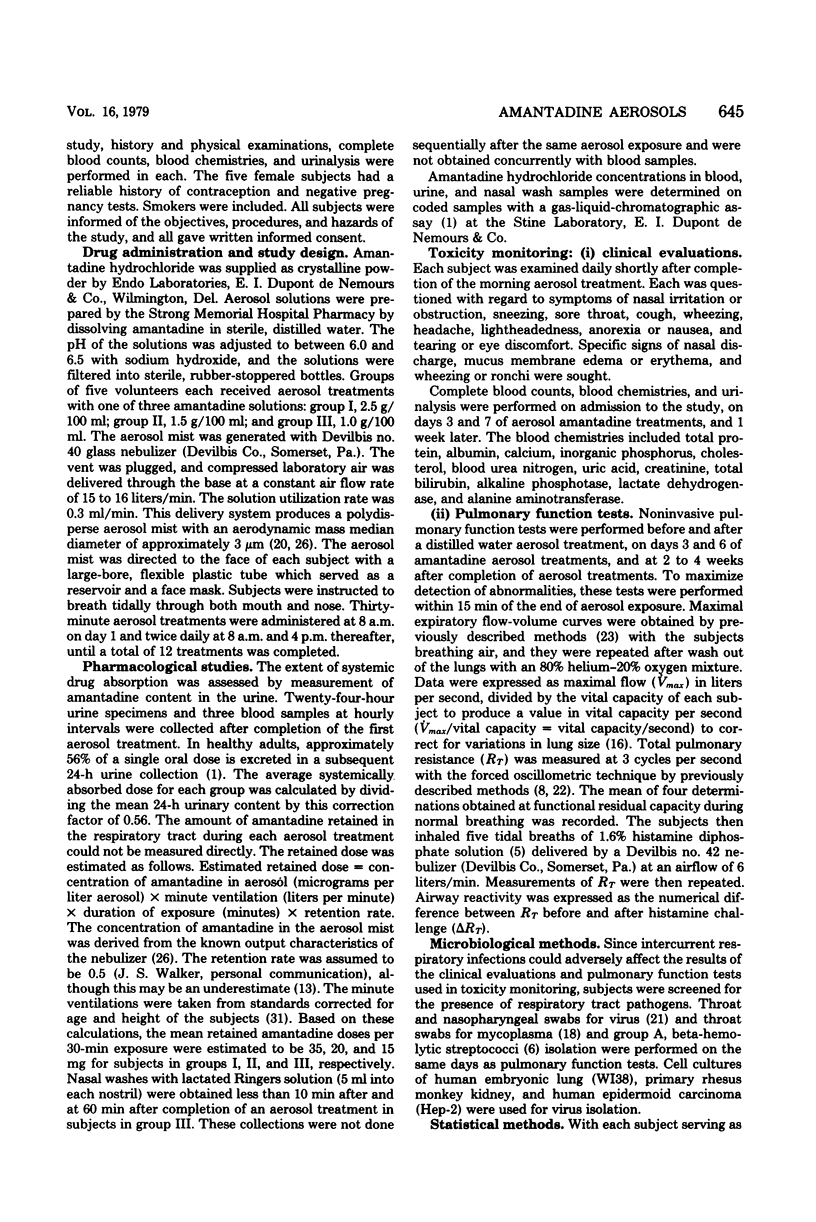
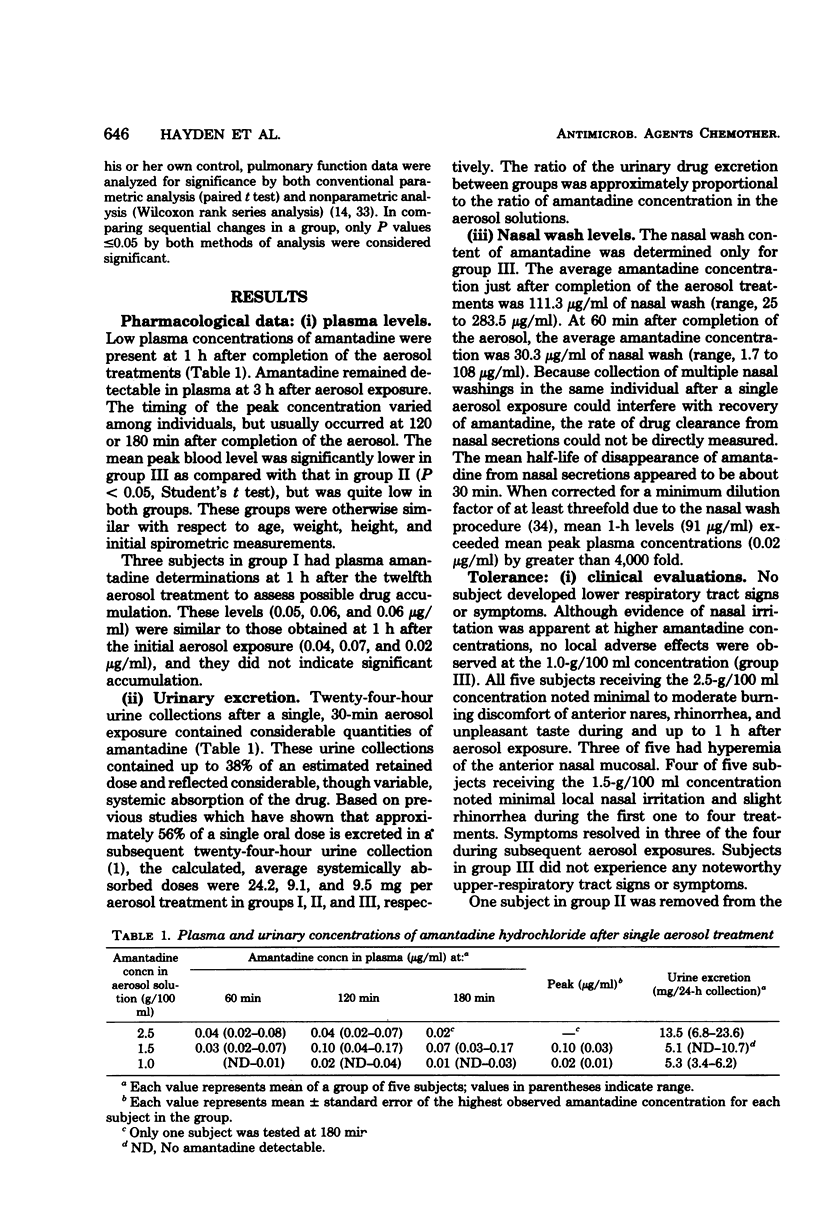
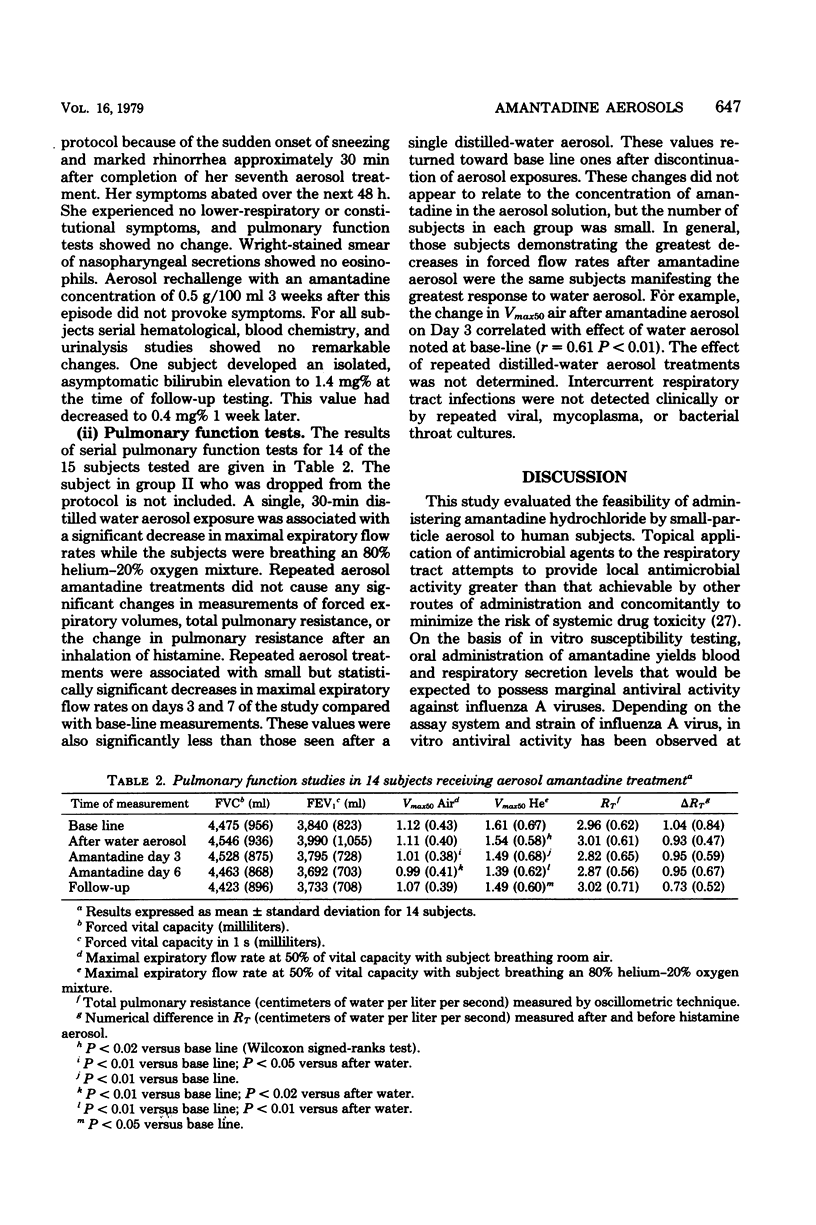
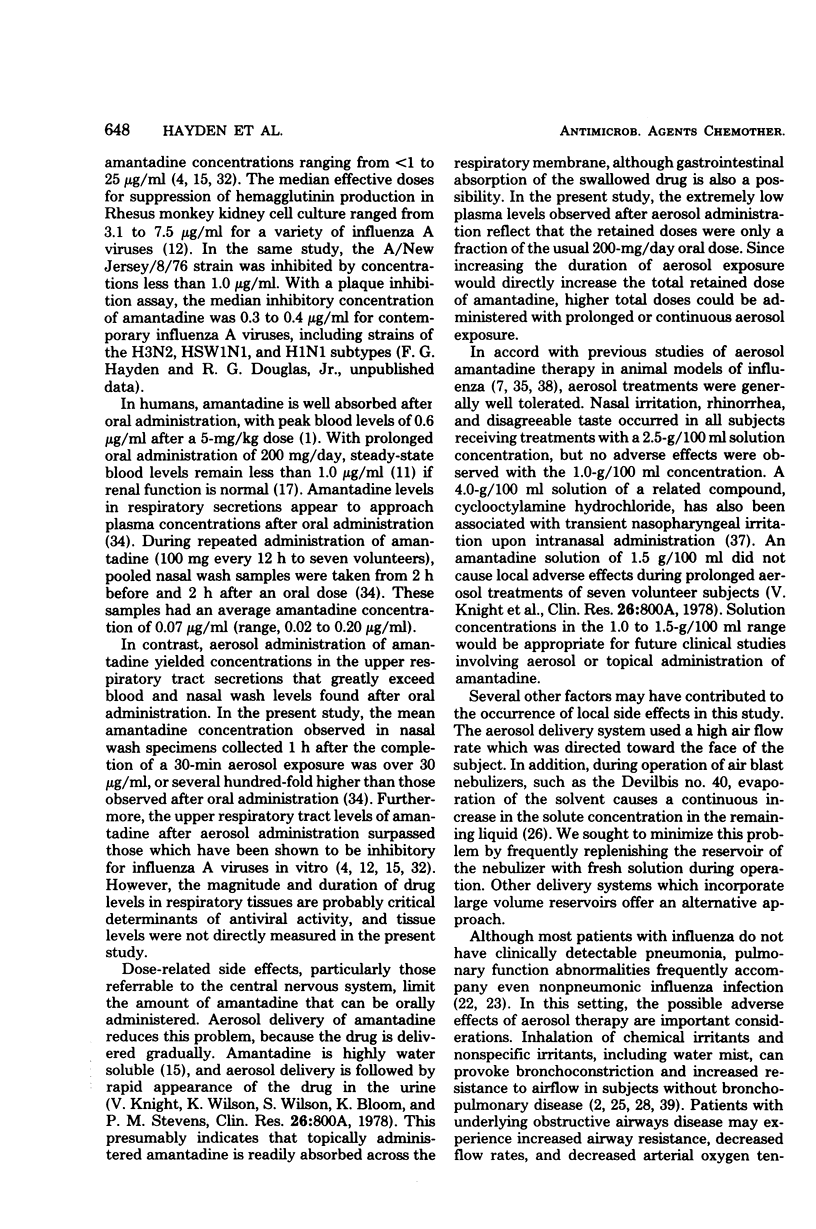
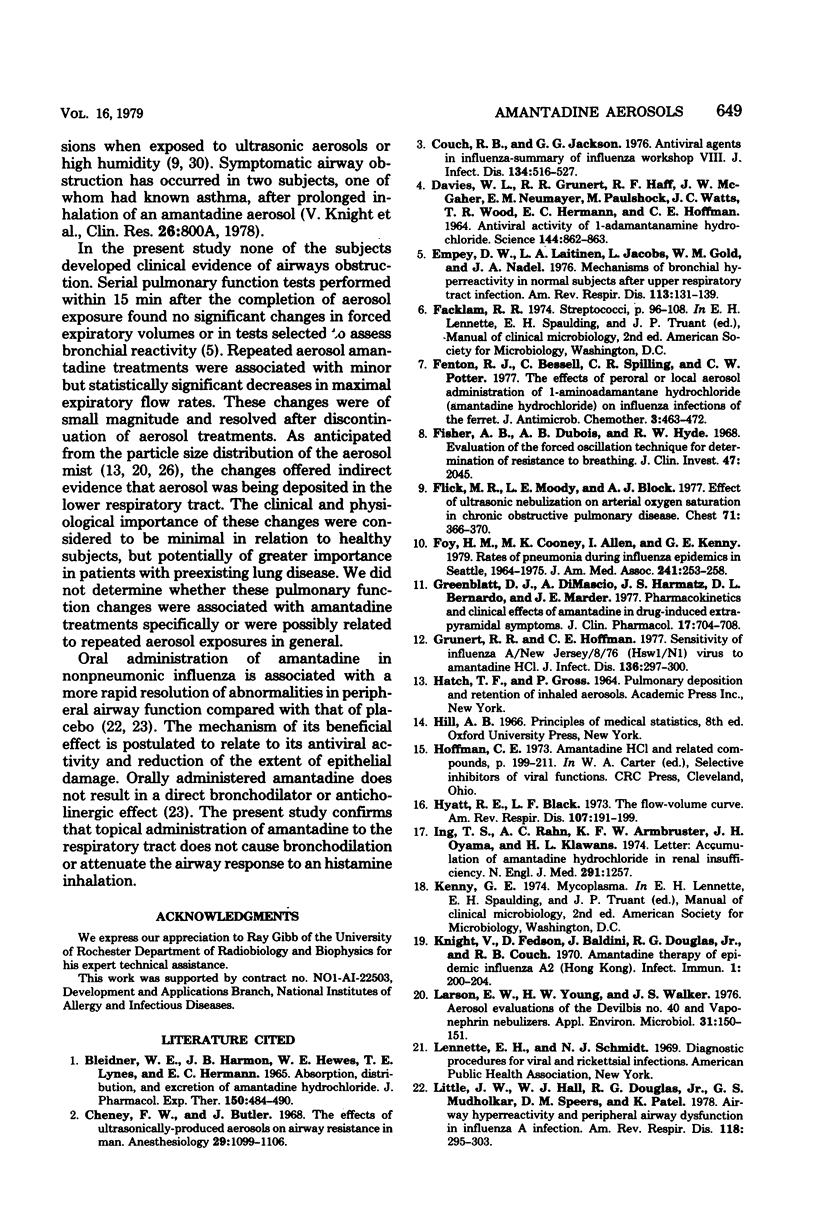
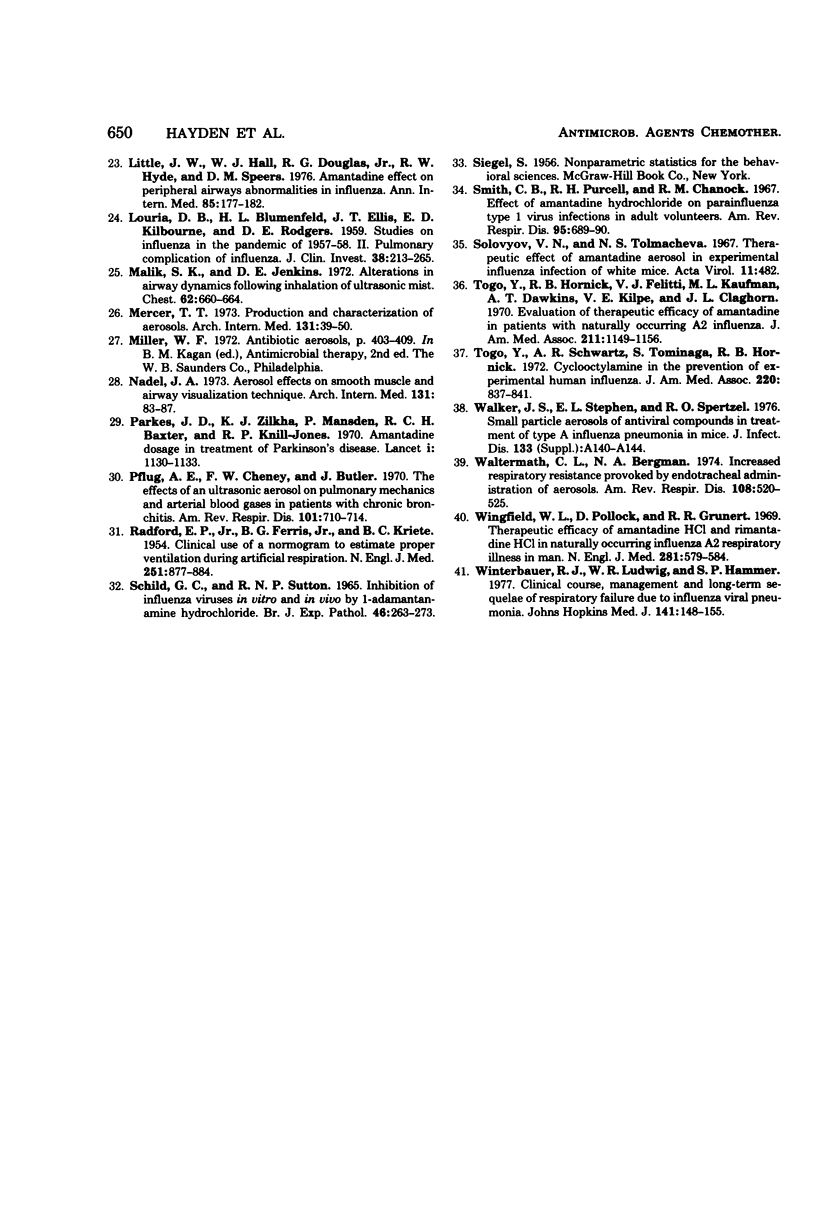
Selected References
These references are in PubMed. This may not be the complete list of references from this article.
- Bleidner W. E., Harmon J. B., Hewes W. E., Lynes T. E., Hermann E. C. Absorption, distribution and excretion of amantadine hydrochloride. J Pharmacol Exp Ther. 1965 Dec;150(3):484–490. [PubMed] [Google Scholar]
- Cheney F. W., Jr, Butler J. The effects of ultrasonically-produced aerosols on airway resistance in man. Anesthesiology. 1968 Nov-Dec;29(6):1099–1106. doi: 10.1097/00000542-196811000-00004. [DOI] [PubMed] [Google Scholar]
- Couch R. B., Jackson G. G. Antiviral agents in influenza--summary of Influenza Workshop VIII. J Infect Dis. 1976 Nov;134(5):516–527. doi: 10.1093/infdis/134.5.516. [DOI] [PubMed] [Google Scholar]
- DAVIES W. L., GRUNERT R. R., HAFF R. F., MCGAHEN J. W., NEUMAYER E. M., PAULSHOCK M., WATTS J. C., WOOD T. R., HERMANN E. C., HOFFMANN C. E. ANTIVIRAL ACTIVITY OF 1-ADAMANTANAMINE (AMANTADINE). Science. 1964 May 15;144(3620):862–863. doi: 10.1126/science.144.3620.862. [DOI] [PubMed] [Google Scholar]
- Empey D. W., Laitinen L. A., Jacobs L., Gold W. M., Nadel J. A. Mechanisms of bronchial hyperreactivity in normal subjects after upper respiratory tract infection. Am Rev Respir Dis. 1976 Feb;113(2):131–139. doi: 10.1164/arrd.1976.113.2.131. [DOI] [PubMed] [Google Scholar]
- Fenton R. J., Bessell C., Spilling C. R., Potter C. W. The effects of peroral or local aerosol administration of 1-aminoadamantane hydrochloride (amantadine hydrochloride) on influenza infections of the ferret. J Antimicrob Chemother. 1977 Sep;3(5):463–472. doi: 10.1093/jac/3.5.463. [DOI] [PubMed] [Google Scholar]
- Fisher A. B., DuBois A. B., Hyde R. W. Evaluation of the forced oscillation technique for the determination of resistance to breathing. J Clin Invest. 1968 Sep;47(9):2045–2057. doi: 10.1172/JCI105890. [DOI] [PMC free article] [PubMed] [Google Scholar]
- Flick M. R., Moody L. E., Block A. J. Effect of ultrasonic nebulization on arterial oxygen saturation in chronic obstructive pulmonary disease. Chest. 1977 Mar;71(3):366–370. doi: 10.1378/chest.71.3.366. [DOI] [PubMed] [Google Scholar]
- Foy H. M., Cooney M. K., Allan I., Kenny G. E. Rates of pneumonia during influenza epidemics in Seattle, 1964 to 1975. JAMA. 1979 Jan 19;241(3):253–258. [PubMed] [Google Scholar]
- Greenblatt D. J., DiMascio A., Harmatz J. S., Bernardo D. L., Marder J. E. Pharmacokinetics and clinical effects of amantadine in drug-induced extrapyramidal symptoms. J Clin Pharmacol. 1977 Nov-Dec;17(11-12):704–708. doi: 10.1002/j.1552-4604.1977.tb01545.x. [DOI] [PubMed] [Google Scholar]
- Grunert R. R., Hoffmann C. E. Sensitivity of influenza A/New Jersey/8/76 (Hsw1N1) virus to amantadine-HCl. J Infect Dis. 1977 Aug;136(2):297–300. doi: 10.1093/infdis/136.2.297. [DOI] [PubMed] [Google Scholar]
- Hyatt R. E., Black L. F. The flow-volume curve. A current perspective. Am Rev Respir Dis. 1973 Feb;107(2):191–199. doi: 10.1164/arrd.1973.107.2.191. [DOI] [PubMed] [Google Scholar]
- Ing T. S., Rahn A. C., Armbruster K. F., Oyama J. H., Klawans H. L. Letter: Accumulation of amantadine hydrochloride in renal insufficiency. N Engl J Med. 1974 Dec 5;291(23):1257–1257. doi: 10.1056/NEJM197412052912320. [DOI] [PubMed] [Google Scholar]
- Knight V., Fedson D., Baldini J., Douglas R. G., Couch R. B. Amantadine therapy of epidemic influenza a(2) (Hong Kong). Infect Immun. 1970 Feb;1(2):200–204. doi: 10.1128/iai.1.2.200-204.1970. [DOI] [PMC free article] [PubMed] [Google Scholar]
- LOURIA D. B., BLUMENFELD H. L., ELLIS J. T., KILBOURNE E. D., ROGERS D. E. Studies on influenza in the pandemic of 1957-1958. II. Pulmonary complications of influenza. J Clin Invest. 1959 Jan;38(1 Pt 2):213–265. doi: 10.1172/JCI103791. [DOI] [PMC free article] [PubMed] [Google Scholar]
- Larson E. W., Young H. W., Walker J. S. Aerosol evaluations of the DeVilbiss No. 40 and Vaponefrin nebulizers. Appl Environ Microbiol. 1976 Jan;31(1):150–151. doi: 10.1128/aem.31.1.150-151.1976. [DOI] [PMC free article] [PubMed] [Google Scholar]
- Little J. W., Hall W. J., Douglas R. G., Jr, Hyde R. W., Speers D. M. Amantadine effect on peripheral airways abnormalities in influenza. A study in 15 students with natural influenza A infection. Ann Intern Med. 1976 Aug;85(2):177–182. doi: 10.7326/0003-4819-85-2-177. [DOI] [PubMed] [Google Scholar]
- Little J. W., Hall W. J., Douglas R. G., Jr, Mudholkar G. S., Speers D. M., Patel K. Airway hyperreactivity and peripheral airway dysfunction in influenza A infection. Am Rev Respir Dis. 1978 Aug;118(2):295–303. doi: 10.1164/arrd.1978.118.2.295. [DOI] [PubMed] [Google Scholar]
- Malik S. K., Jenkins D. E. Alterations in airway dynamics following inhalation of ultrasonic mist. Chest. 1972 Dec;62(6):660–664. doi: 10.1378/chest.62.6.660. [DOI] [PubMed] [Google Scholar]
- Mercer T. T. Production and characterization of aerosols. Arch Intern Med. 1973 Jan;131(1):39–50. [PubMed] [Google Scholar]
- Nadel J. A. Aerosol effects on smooth muscle and airway visualization technique. Arch Intern Med. 1973 Jan;131(1):83–87. [PubMed] [Google Scholar]
- Parkes J. D., Zilkha K. J., Marsden P., Baxter R. C., Knill-Jones R. P. Amantadine dosage in treatment of Parkinson's disease. Lancet. 1970 May 30;1(7657):1130–1133. doi: 10.1016/s0140-6736(70)91211-0. [DOI] [PubMed] [Google Scholar]
- Pflug A. E., Cheney F. W., Jr, Butler J. The effects of an ultrasonic aerosol on pulmonary mechanics and arterial blood gases in patients with chronic bronchitis. Am Rev Respir Dis. 1970 May;101(5):710–714. doi: 10.1164/arrd.1970.101.5.710. [DOI] [PubMed] [Google Scholar]
- RADFORD E. P., Jr, FERRIS B. G., Jr, KRIETE B. C. Clinical use of a nomogram to estimate proper ventilation during artificial respiration. N Engl J Med. 1954 Nov 25;251(22):877–884. doi: 10.1056/NEJM195411252512201. [DOI] [PubMed] [Google Scholar]
- Schild G. C., Sutton R. N. Inhibition of influenza viruses in vitro and in vivo by 1-adamantanamine hydrochloride. Br J Exp Pathol. 1965 Jun;46(3):263–273. [PMC free article] [PubMed] [Google Scholar]
- Smith G. B., Purcell R. H., Chanock R. M. Effect of amantadine hydrochloride on parainfluenza type 1 virus infections in adult volunteers. Am Rev Respir Dis. 1967 Apr;95(4):689–690. doi: 10.1164/arrd.1967.95.4.689. [DOI] [PubMed] [Google Scholar]
- Solovyov V. N., Tolmacheva N. S. Therapeutic effect of adamantanamine aerosol in experimental influenza infection of white mice. Acta Virol. 1967 Sep;11(5):482–482. [PubMed] [Google Scholar]
- Togo Y., Hornick R. B., Felitti V. J., Kaufman M. L., Dawkins A. T., Jr, Kilpe V. E., Claghorn J. L. Evaluation of therapeutic efficacy of amantadine in patients with naturally occurring A2 influenza. JAMA. 1970 Feb 16;211(7):1149–1156. [PubMed] [Google Scholar]
- Togo Y., Schwartz A. R., Tominaga S., Hornick R. B. Cyclooctylamine in the prevention of experimental human influenza. JAMA. 1972 May 8;220(6):837–841. [PubMed] [Google Scholar]
- Walker J. S., Stephen E. L., Spertzel R. O. Small-particle aerosols of antiviral compounds in treatment of type A influenza pneumonia in mice. J Infect Dis. 1976 Jun;133 (Suppl):A140–A144. doi: 10.1093/infdis/133.supplement_2.a140. [DOI] [PubMed] [Google Scholar]
- Waltemath C. L., Bergman N. A. Increased respiratory resistance provoked by endotracheal administration of aerosols. Am Rev Respir Dis. 1973 Sep;108(3):520–525. doi: 10.1164/arrd.1973.108.3.520. [DOI] [PubMed] [Google Scholar]
- Wingfield W. L., Pollack D., Grunert R. R. Therapeutic efficacy of amantadine HCl and rimantadine HCl in naturally occurring influenza A2 respiratory illness in man. N Engl J Med. 1969 Sep 11;281(11):579–584. doi: 10.1056/NEJM196909112811102. [DOI] [PubMed] [Google Scholar]
- Winterbauer R. H., Ludwig W. R., Hammar S. P. Clinical course, management, and long-term sequelae of respiratory failure due to influenza viral pneumonia. Johns Hopkins Med J. 1977 Sep;141(3):148–155. [PubMed] [Google Scholar]


